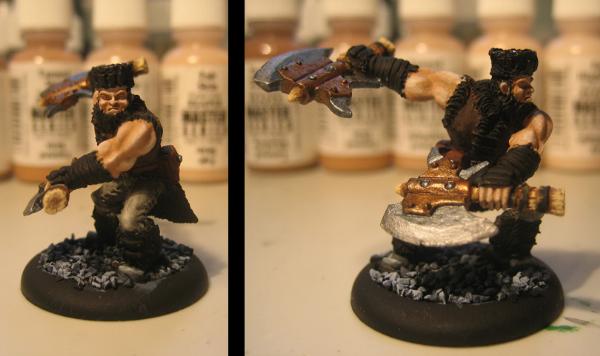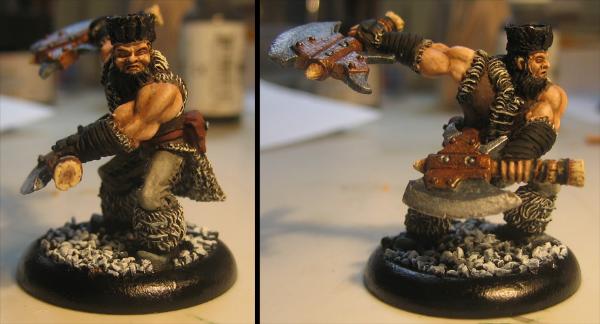| Author |
Message |
 |
|
|
 |
|
Advert
|
Forum adverts like this one are shown to any user who is not logged in. Join us by filling out a tiny 3 field form and you will get your own, free, dakka user account which gives a good range of benefits to you:
- No adverts like this in the forums anymore.
- Times and dates in your local timezone.
- Full tracking of what you have read so you can skip to your first unread post, easily see what has changed since you last logged in, and easily see what is new at a glance.
- Email notifications for threads you want to watch closely.
- Being a part of the oldest wargaming community on the net.
If you are already a member then feel free to login now. |
|
 |
![[Post New]](/s/i/i.gif) 2008/05/20 19:06:13
Subject: White Dwarf Tutorial Help
|
 |

Battlefortress Driver with Krusha Wheel
|
I've been painting for a while now and am quite happy with my skill level - reasonable table top quality, probably never enter Golden Demon though! I have decided it's time to up my game a little though for the character models in my armies and thought that a good way to go about doing this would be to try and paint a specific model where there is an 'eavy metal masterclass in white dwarf. There's always one problem though - due to the limitations on printing space, they clearly only ever show you 3 or 4 stages of painting. It's pretty obvious from looking at the photos that tonnes of work has been done between two consecutive photos, but for those of us with less talent than the 'eavy metal team, it's not always obvious how to get that effect. For example, if you take the most recent White Dwarf (UK Issue 342), there's a tutorial for painting Skulltaker. If you look on page 97, it shows you how the skulls were painted, although there is a lot of blending between the stages. most notably though, is the 'cloak detail' shown on page 96. How you get from stage 3 to stage 4 with the description they give, I just cannot work out!
What I am humbly asking, is whether or not a member of DakkaDakka with the required level of skill could do a full tutorial with every single stage of painting shown in it? I'm sure a lot of people would really appreciate it as it can be very hard to learn if you don't have actual access to someone who's a better painter than yourself. It wouldn't have to be a full model, but a full stage by stage tutorial with good photos of something small, like a skull, cloth, armour detail or similar would be a massive help.
Thank you in advance to anyone who can take up the baton!
|
|
|
|
 |
 |
![[Post New]](/s/i/i.gif) 2008/05/20 20:56:23
Subject: White Dwarf Tutorial Help
|
 |

Grumpy Longbeard
|
I don't have the issue in question, but most of the time it's a case of mixing the paints in smaller increments than they say. So if it says scorched brown-scab red-blood red, start with scorched brown then add small amounts of scab red for each highlight, then once you're at scab red add small amounts of blood red untill you get to pure blood red. Hope that helps a little.
|
Opinions are like arseholes. Everyone's got one and they all stink. |
|
|
 |
 |
![[Post New]](/s/i/i.gif) 2008/05/20 21:09:52
Subject: White Dwarf Tutorial Help
|
 |

Battlefortress Driver with Krusha Wheel
|
Thanks Greebynog, that's pretty much what I thought, but it would be really helpful to be able to see it all....
|
|
|
|
 |
 |
![[Post New]](/s/i/i.gif) 2008/05/20 21:17:49
Subject: White Dwarf Tutorial Help
|
 |

Grumpy Longbeard
|
There's some great tutorials (with pictures) here: http://www.brushthralls.com/painting-techniques/2.html they might help you out.
|
Opinions are like arseholes. Everyone's got one and they all stink. |
|
|
 |
 |
![[Post New]](/s/i/i.gif) 2008/05/21 01:29:01
Subject: White Dwarf Tutorial Help
|
 |

Tunneling Trygon
|
There's basically three ways to get a blend.
One is layering. This is good for rank and file, and is what pretty much everyone starts out with. I'm sure you're familliar with it, but basically it's just layering paint up in a gradient. The actual transitions of color are pretty hard, but when viewed from more than a few inches away, it's hard to spot. It's not actual blending, it's the illusion of blending.
Another is glazing or feathering. There are different ways to approach this, but generally what it you're doing is layering, but with translucent paint. This allows you to get some amount of true blending. Because it's all the same paint, it's easier to do many small steps of gradient, and to smooth more. The trick here is good paint opacity control, keeping it the right thickness on your palette.
The last is "two brush" or "wet blending." This is again similar to layering, but in this technique you keep a second brush on hand, often tucked into your brush hand, which is damp and is used to smooth and feather the paint as you apply it with your paint laden brush. This is similar to feathering, the results are the same, but it requires a different skillset and approach. The trick here is controlling two brushes.
|
|
|
|
 |
 |
![[Post New]](/s/i/i.gif) 2008/05/21 20:53:55
Subject: White Dwarf Tutorial Help
|
 |

Battlefortress Driver with Krusha Wheel
|
Phryxis wrote:There's basically three ways to get a blend.
One is layering. This is good for rank and file, and is what pretty much everyone starts out with. I'm sure you're familliar with it, but basically it's just layering paint up in a gradient. The actual transitions of color are pretty hard, but when viewed from more than a few inches away, it's hard to spot. It's not actual blending, it's the illusion of blending.
Another is glazing or feathering. There are different ways to approach this, but generally what it you're doing is layering, but with translucent paint. This allows you to get some amount of true blending. Because it's all the same paint, it's easier to do many small steps of gradient, and to smooth more. The trick here is good paint opacity control, keeping it the right thickness on your palette.
The last is "two brush" or "wet blending." This is again similar to layering, but in this technique you keep a second brush on hand, often tucked into your brush hand, which is damp and is used to smooth and feather the paint as you apply it with your paint laden brush. This is similar to feathering, the results are the same, but it requires a different skillset and approach. The trick here is controlling two brushes.
Can I ask a couple of questions about this?
Method 1, layering, this is probably what I'm doing now - mix the colour I want, dilute it, paint it on. Adjust the mix a bit for a slightly different colour for the next layer, paint it on. Repeat ad infinitum.
Method 2, glazing or feathering, am I right in thinking that if you want to go from say scab red to blood red, you paint scab red as your base. Then have just blood red and water mixed so that the mix is like milk, then paint in many translucent layers until you get to blood red?
Method 3, wet blending, I don't think I quite understand what you mean. Surely the second brush will just get covered in paint and pull it off the model? Could you explain a bit more?
Thanks!
|
|
|
|
 |
 |
![[Post New]](/s/i/i.gif) 2008/05/27 09:34:55
Subject: White Dwarf Tutorial Help
|
 |

Battlefortress Driver with Krusha Wheel
|
Just wondering if anyone could answer my questions in the previous post please?
|
|
|
|
 |
 |
![[Post New]](/s/i/i.gif) 2008/05/27 15:47:32
Subject: White Dwarf Tutorial Help
|
 |

Regular Dakkanaut
|
I'm no expert, but I'll give it a shot for you.
Method 2 will work as you describe, but works better if you gradually modify the shade of the paint as you would in Method 1 and keep it very thin. This would be the feathering part. The glaze is another very thin shade of paint that you apply over the whole section to just slightly modify the tone of all the layers which helps it look like a smoother more cohesive blend. Glazing also helps makes colours "richer", especially reds. Glazes are generally darker than the layers underneath them. Here's an example:
Method 1/2 used to build up the flesh highlights...

Then a glaze applied over all the flesh to help unify the layers...

NB I also used a thicker version of the glaze colour to darken the deepest recesses in this example.
Method 3 - Mike McVey advocates this type of blending in the Warmachine Prime Remix painting guide, but I can't even begin to get it to work properly. Perhaps someone else can chip in.
|
"Being given the opportunity to know, and nevertheless shunning knowledge, creates direct responsibility for the consequences." -Albert Speer |
|
|
 |
 |
![[Post New]](/s/i/i.gif) 2008/05/27 17:36:02
Subject: White Dwarf Tutorial Help
|
 |

Tzeentch Aspiring Sorcerer Riding a Disc
|
Your method 1 works best with lots of layers, and with proper amounts of matt medium or water in your paints. The upper layers can be translucent, but you still want to mix the two colors together to produce a fine gradient.
I would like to explain wet blending a little more, but I'm going to have to experiment a bit with it. The second brush will get paint on it, but it will also thin down the paint on the mini, and move the paint around in small quantities. That is what you are going for after all.
However, I find the technique is meant to save time from layered blending, and I also find that multiple layers and glaze coats work best for me.
|
|
|
|
 |
 |
|
|